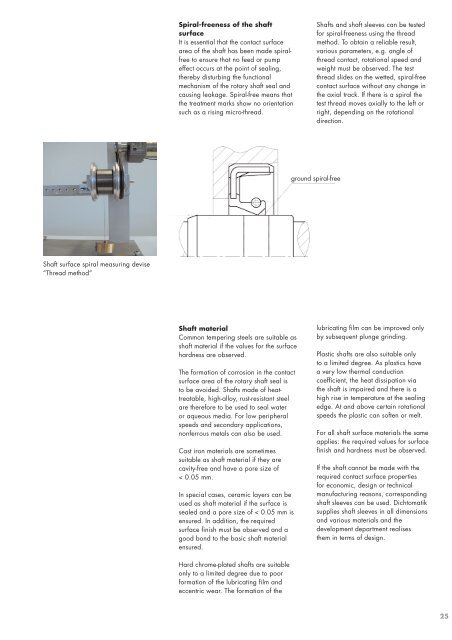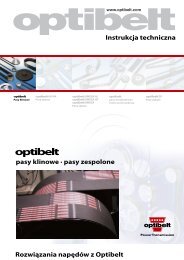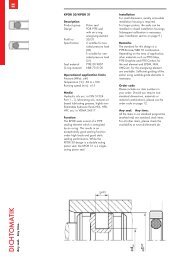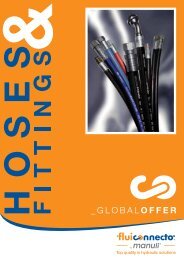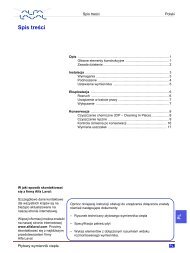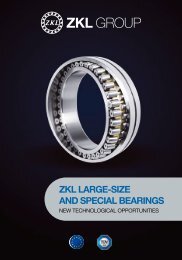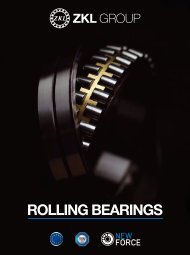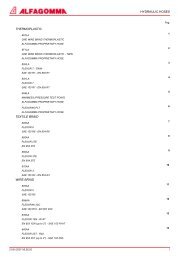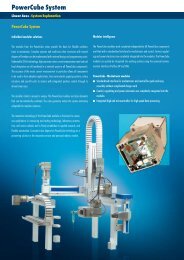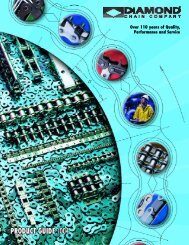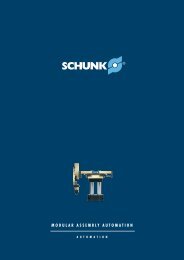DICHTOMATIK
DICHTOMATIK - Spinet
DICHTOMATIK - Spinet
- No tags were found...
You also want an ePaper? Increase the reach of your titles
YUMPU automatically turns print PDFs into web optimized ePapers that Google loves.
Spiral-freeness of the shaft<br />
surface<br />
It is essential that the contact surface<br />
area of the shaft has been made spiralfree<br />
to ensure that no feed or pump<br />
effect occurs at the point of sealing,<br />
thereby disturbing the functional<br />
mechanism of the rotary shaft seal and<br />
causing leakage. Spiral-free means that<br />
the treatment marks show no orientation<br />
such as a rising micro-thread.<br />
Shafts and shaft sleeves can be tested<br />
for spiral-freeness using the thread<br />
method. To obtain a reliable result,<br />
various parameters, e.g. angle of<br />
thread contact, rotational speed and<br />
weight must be observed. The test<br />
thread slides on the wetted, spiral-free<br />
contact surface without any change in<br />
the axial track. If there is a spiral the<br />
test thread moves axially to the left or<br />
right, depending on the rotational<br />
direction.<br />
ground spiral-free<br />
Shaft surface spiral measuring devise<br />
“Thread method”<br />
Shaft material<br />
Common tempering steels are suitable as<br />
shaft material if the values for the surface<br />
hardness are observed.<br />
The formation of corrosion in the contact<br />
surface area of the rotary shaft seal is<br />
to be avoided. Shafts made of heattreatable,<br />
high-alloy, rust-resistant steel<br />
are therefore to be used to seal water<br />
or aqueous media. For low peripheral<br />
speeds and secondary applications,<br />
nonferrous metals can also be used.<br />
Cast iron materials are sometimes<br />
suitable as shaft material if they are<br />
cavity-free and have a pore size of<br />
< 0.05 mm.<br />
In special cases, ceramic layers can be<br />
used as shaft material if the surface is<br />
sealed and a pore size of < 0.05 mm is<br />
ensured. In addition, the required<br />
surface finish must be observed and a<br />
good bond to the basic shaft material<br />
ensured.<br />
lubricating film can be improved only<br />
by subsequent plunge grinding.<br />
Plastic shafts are also suitable only<br />
to a limited degree. As plastics have<br />
a very low thermal conduction<br />
coefficient, the heat dissipation via<br />
the shaft is impaired and there is a<br />
high rise in temperature at the sealing<br />
edge. At and above certain rotational<br />
speeds the plastic can soften or melt.<br />
For all shaft surface materials the same<br />
applies: the required values for surface<br />
finish and hardness must be observed.<br />
If the shaft cannot be made with the<br />
required contact surface properties<br />
for economic, design or technical<br />
manufacturing reasons, corresponding<br />
shaft sleeves can be used. Dichtomatik<br />
supplies shaft sleeves in all dimensions<br />
and various materials and the<br />
development department realises<br />
them in terms of design.<br />
Hard chrome-plated shafts are suitable<br />
only to a limited degree due to poor<br />
formation of the lubricating film and<br />
eccentric wear. The formation of the<br />
25


